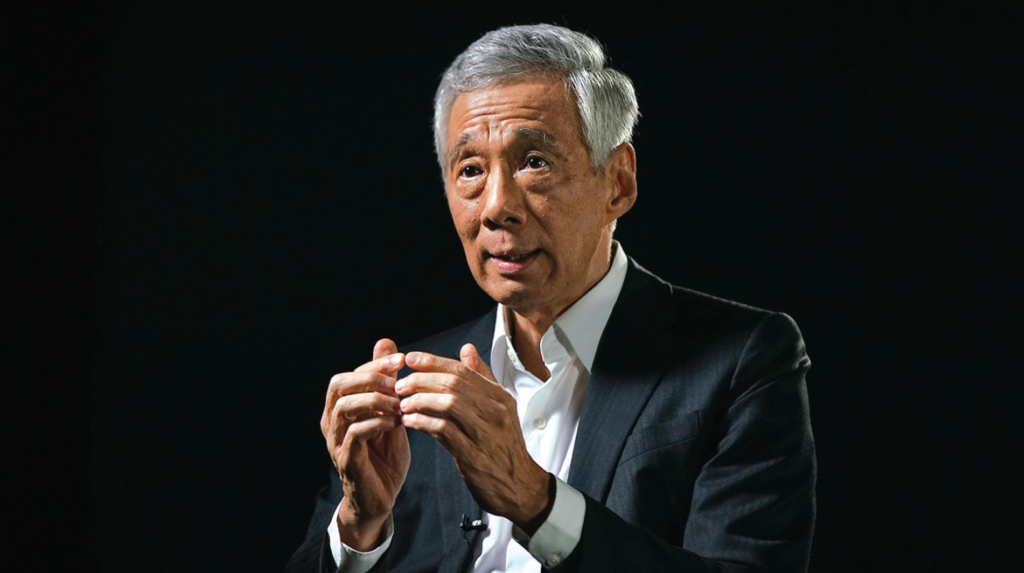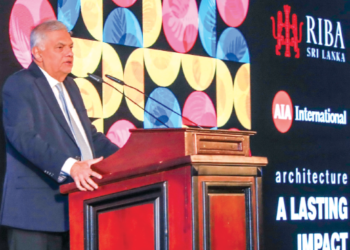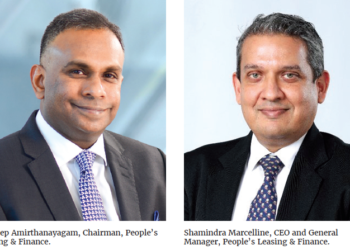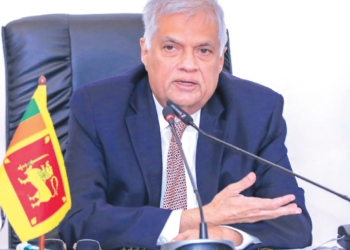When countries struggle to boost investments amid a torrent of corruption and policy inconsistency and are paying the price for poor investment decisions, Singapore tells its story of how it built its reserves from nothing, a third-world country at independence in 1965. Political sagacity to nation-building by its forefathers and their successors, separating business from politics, has helped Singapore become a regional pivot. Everyone wants to learn a lesson or two from them. But even today, having weathered a few storms in the recent past, its leaders are refusing to take its position for granted. Prime Minister Lee Hsien Loong tells how Singapore, since independence, built its reserves through political will and commitment and has a warning for its next generation of leaders and citizens.
By Jennifer Paldano Goonewardane.

Prime Minister of Singapore Lee Hsien Loong.
He calls it the “Singapore Premium”. Prime Minister of Singapore, Lee Hsien Loong, considers his country’s reserves a great source of comfort and reassurance, the saving grace in times of crisis. It will be their cashbox that they can dip into to avert a calamity. Singapore has an extensive national reserve that it considers a rainy day fund, an inheritance from the nation’s forefathers who prudently saved for the future so that even without the privilege of natural resources, it would be substantial in helping to survive a crisis. In managing its national reserves, two sovereign reserve funds, Temasek and the GIC, were created by its leaders, unique models in Asia to grow its reserves by expanding its global portfolio. During an interview with CNA for a two-part documentary “Singapore’s Reserves Revealed”, Prime Minister Lee Hsien Loong spoke on the role of the country’s leaders, beginning with independence, and since then, how successive governments have pivoted towards consolidating the protection mechanisms around the country’s reserves so that by protecting them and growing them, the country has a formidable surety to turn to in times of crises while also strengthening the constitution to prevent its misuse.
Solidifying its Reserves
The temptation for politicians to interfere in government-linked companies (GLCs) was why Singapore’s leaders separated state-owned companies from ministry control. GLCs became noncompetitive and lost commercial and market discipline owing to the succor they received from the ministries. Political interference is inevitable. It became a two-way scourge of political interference in those institutions that, in turn, sought State support to remain afloat. As newly independent Singapore sought to accelerate its nation-building efforts and push for investment in strategic sectors to spur private investment and push for self-sufficiency, it had to change the status quo and rewrite the trajectory.
Temasek is a State-owned private limited company set up in 1974, initially as a holding company to manage GLCs. Over time it has expanded its mandate to become a stealthy investor making good returns on investment. It has become a global investment company with an extensive portfolio in financial services, transportation and industries, telecommunications, media and technology, consumer, real estate, agriculture and life sciences. The objective of Temasek was to strengthen its contribution to the Singaporean economy, ensure its resilience through prudent investments, and create successful companies devoid of political interference. Temasek holds shares on behalf of the Singapore government. In pursuing its development agenda, Temasek buys stakes in companies, at home and outside, reinvesting capital gains and dividend income in foreign assets.
Since Temasek has evolved over the years to play a dynamic role in the Singaporean economy, the Board members, drawn from the political elite, can make investment decisions without government interference. Since 2009, it has replaced its earlier mandate of being a strategic investor to become a commercial investor aiming to create long-term wealth changing its earlier stance of following the government’s economic agenda. The extent to which the government provides the space to function in an independent environment with the proper checks and balances is evident in its financial independence, having received no State assistance since its inception.
Companies taken out of finance, industry and trade ministry control and brought under the management of Temasek, some of which, such as defense, telecommunication and aviation, were entities formed during British rule. However, the objective was beyond simply amalgamating GLCs under one umbrella. The newly formed investment company had to rationalize its portfolio of companies and give reasons for holding them, their value and viability. Where companies failed to meet the country’s needs, Temasek sold them or eventually wound them up. Companies deemed valuable and having the potential to grow continued under the stewardship of Temasek, directing them into investment in new areas, diversifying their portfolios and diversifying Singapore’s portfolio in the Asia-Pacific region and the developed world. Under Temasek’s watch, public service providers in electricity, utilities and broadcasting were privatized to increase competition as envisaged by the government.
Setting up the GIC, formerly known as the Government of Singapore Investment Corporation, a sovereign wealth fund of the Government of Singapore, was to create a separate and robust role in harnessing the benefits of the country’s foreign reserves. It is described as the central bank’s money manager. The government understood that its central bank, the Monetary Authority of Singapore (MAS), could not simultaneously be a regulator and fund manager. The central bank continued its role in deciding the monetary policy. The GIC was set up in 1981 from the surplus foreign exchange reserves, which have become an annual transfer from the government to make long-term and flexible investments in public equities, fixed income, real estate and private equity. Its role allows it to take a longer-term view and even more significant risks, investing the foreign reserves on behalf of the government, the MAS, and the Ministry of Finance in portfolios that have given good returns over the years.
Singapore’s significant reserves also meant that there should be checks and balances with more people with the power to control and manage it for the future. Singapore’s leadership focuses on honoring the role played by the forbears of the city-state that rose from scratch to build a formidable national reserve for the future, a position that every government is cognizant of, of building on the reserves for future generations.
Hence the focus is on prudent investment. Importantly, Loong pointed out that its leaders recognized the size of the reserves and hence the need to build more guardrails against its misuse and in favor of its preservation, a contrast to instances where sovereign reserves have been a temptation to leaders who have imprudently spent them, profiting in the process, plunging their nations into distress and stripping their citizens of what is rightfully theirs.
Appointing a Second Key
In 1990, according to an idea floated by former Prime Minister Lee Kuan Yew to have a second key to managing the country’s reserves, parliament amended the constitution, making way for a president appointed by popular vote, which was hitherto selected by parliament, giving the position more credence, as it demonstrates the public’s confidence in the individual they appoint to manage their national reserves. Pushing for an elected president was also a turning point in crystallizing the importance of federal reserves in people’s psyche, as protecting the country’s substantial reserves by having more safeguards had been a recurring concern of its early rulers. Prime Minister Loong remembered when former Prime Minister Lee Kuan Yew had raised this concern in 1984 at a national day rally, using the phrase to warn that the day Singapore gets a rogue government that would be the end of its national reserves. Lee Kuan Yew warned that a rogue government and the wrong team in place would pillage the country’s reserves to the ground, erasing the life savings of generations of Singaporeans. Cognizant of future scenarios, Lee was committed to preventing such an outcome by strengthening the constitution to put the second key in the hands of a people-elected president. Loong praised the wisdom of Singapore’s leaders in taking measures through the constitution to prevent any rogue government of the future from marauding the reserves but also prompts incumbent governments to take a step back in spending, to practice a degree of restraint when dipping into the reserves. The Government of Singapore can draw upon its reserves only with the approval of its President, who also has the power to veto a budget if it is deemed likely to draw upon the country’s reserves for reckless spending.
Protecting Institutional Independence
The two formidable State sponsored entities managing Singapore’s reserves maintain extensive investments in America, Europe, India, and China and emerging markets with a degree of risk-taking with the probability of different outcomes. That is a likelihood the government is aware of but vigorously pursues over confining its reserves to archaic investments. The government vigorously defends the independence of these two institutions, especially from being influenced by political meddling, a departure from the general rule of political interference and dictating in the affairs of institutions even remotely connected to the government. It does so by appointing a competent and honest team of officials accompanied by a mission, authority, and governance prerogatives, which has helped expand the investment portfolio and witness the reserves grow over a long period. Protecting the people leading these institutions, said the Prime Minister, is the duty of every elected political leader who, in turn, is accountable to the public. Hence, the degree of autonomy those officials enjoy to use their discretion in investing the country’s reserves bears upon the outcome, an outcome that can either positively or adversely impact the citizenry.
Loong praised the wisdom of Singapore’s leaders in taking measures through the constitution to prevent any rogue government of the future from marauding the reserves but also prompts incumbent governments to take a step back in spending, to practice a degree of restraint when dipping into the reserves.
There is pride and anxiety in the leadership regarding the future of their sovereign reserves. Pride that as a small country that was a developing nation fifty years ago has eclipsed its neighbors to become a first-world country, having made wise investment decisions to fatten its coffers. Anxiety to preserve its status. Because as PM Loong explained, in the 1970s and 1980s, Singapore was growing by single and double digits with budget surpluses and rising incomes, which allowed the country to save. Although today the country still enjoys high incomes and living standards, people’s expectations and needs have also grown, making it harder to put aside a percentage of the GDP to fortify the reserves. The PM likened Singapore to the Garden of Eden state. But he had a warning too. He said that if you get out of the Garden of Eden, there is no return. Hence, the greater onus to preserve the status quo, a status quo that generates respect globally, the red passport that stands for a people that can command high wages, are educated, organized and skilled. The 2008 global financial crisis and the COVID-19 pandemic were lessons that showed Singapore the inviolability and the vulnerability of its reserves, the “rainy day money” the government had to dip into to ensure that the economy stayed afloat.
How Singapore used its Reserves in Crises
The first time the government dipped into its reserves was when it had to respond vigorously to the 2008 economic crisis, which threatened to derail the global financial system and demanded aggressive responses and new budgetary allocations. The government had to prepare a response to the fallout, with no choice but to bring the budget forward to respond robustly to any knock-on effect.
The government decided on two significant measures. One was the Job Credit Scheme. It spent over $4 billion to keep people at work, helping to pay a substantial part of their wages, effectively their provident fund. The other initiative, the Special Risk-Sharing Initiative, ensured that companies who needed credit could continue to receive it, and good companies would not end up closing because their credit lines dried up or because they refused to lend. This way, the economy functioned. The economy turned around quickly, while the $4 billion allocated to buttress the fallout had been channeled efficiently and with positive outcomes. Before the end of its term, the government had successfully paid back the money drawn from the reserves. The result of COVID-19 was different, however. The government had to pull $40 billion to keep the economy going. PM Loong doubted whether the country could return that amount to the coffers soon.
He said the scale of the COVID-19 crisis was enormous and was sudden, taking the global community unawares. He described it as the storm of the century. The global financial crisis unfolded gradually with the collapse of Bear Stearns in March 2008, followed by the gradual build-up of more problems that alerted governments that were becoming aware of the unfolding situation leading to the collapse of Lehman Brothers in September 2008. COVID-19 and its impact differed. It was severe. The 2020 budget was considered a generous package to help Singaporeans weather the storm, and there seemed to be little need to take the reserves despite the President conveying her desire to consider consenting to it if the government deems it necessary. However, the situation changed rapidly after the budget, forcing the government to make supplementary budgets. The situation demanded rapid responses, and the government had to make its case before the President to use its reserves to respond to the COVID-induced crisis. Singapore could do it because it had a substantial base of funds, enabling it to support livelihoods and preserve people’s jobs while not falling into debt, a very different story to countries in the developing world that saw their fortunes plummet.
Net Investment Returns Contribution (NIRC)
Singapore apportions its dividends and interest income, and capital gains equally, 50-50, one half saved for the future and the other to meet current expenses, including to cover deficits. Singapore gets a substantial NIRC, which amounts to one-fifth of government revenue, 3.5 per cent of GDP, more than the defense, health and education expenditure, and equal to revenues from corporate income tax and 1.4 times more than personal income tax revenue and 1.3 times more than the GST revenue. Thanks to the substantial NIRC, the government is not driven to adjust the domestic tax structure.
However, PM Loong admitted that Singapore had been unwise as well. At one point, it spent the entire income from the principal sum. At the same time, they had yet to consider investing systematically and comprehensively. To the government, income came only as interest and dividends, failing to focus on capital gains from assets. Eventually, the maturing process set in, and the government realized that moving forward meant looking beyond mere earnings from dividends and interest payments to investing in assets and stocks that appreciate over time but may not earn many rewards. However, it will grow, stimulating the country’s growth as it stands to augment capital gains from such investments. Therefore, the government turned its attention to enlarging its returns over income in making future investment choices.
At the same time, the government was also aware of the challenges, the ups and downs and the volatility of markets, which could swing the pendulum in any direction. However, the government had to take the bold step of making investment choices over passing the burden of strengthening its revenue through increased taxing. PM Loong explained how they had turned to Ivy League Universities in the USA to learn how they invested their endowments prudently, investing in a slew of stocks, bonds and other investment options and using their returns to meet current expenses. For Singapore, this was a learning process, but in doing so, it realized the importance of having the right people in decision-making positions. The Council of Presidential Advisors, which gives the President direction in exercising discretionary power related to fiscal matters, vets the process. MAS, GIC, and Temasek apply the same framework in their decision-making.
However, PM Loong admitted that Singapore’s reality has changed. While people earn more, expenditure is soaring, savings have dropped and return on investments are slowing. In making their way to the fourth generation of leaders, PM Loong said that he believes they know the reality. The challenge is also to communicate this reality to its citizenry and take appropriate steps to mitigate the adverse effects by consolidating the country’s reserves. He believes Singapore still has time to consolidate its position amid the looming threats. He said Singapore not only has the time to prepare for the future, learning from countries that have built enormous debt because of unwise decisions and poor leadership, but also has the strength of political determination to get the job done. His advice to the 4G leaders as to the people of Singapore is to hold their reserves like a treasure, use them only when necessary, but be mindful not to fritter them away. It will never return, he warned. True. After all, no one re-entered the Garden of Eden once banished.





